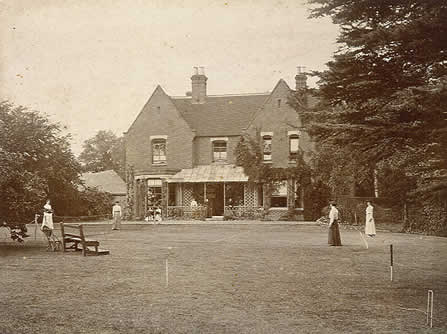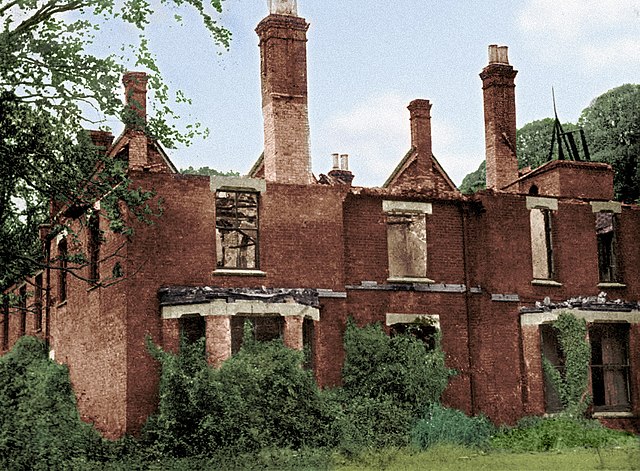
Two things immediately caught my eye about The Banishing, which begins streaming on Shudder on April 15. One, Jessica Brown Findlay, who played one of my favorite Downton Abbey characters, stars in it. Two, its description claimed it’s “the true story of the most haunted house in England.”
Oh really? And which most haunted house in England might that be?
The U.K. isn’t one of the top five countries with the best paranormal tourism for no reason. England especially abounds with haunted places, including haunted houses. Not that you can tour all of them, but certainly anything labeled “the most haunted” would draw curiosity seekers.
So what house earned such a distinction, why, and is it really deserving of it? Let’s see what we can find out.
England’s Most Haunted House: Borley Rectory
In its review of The Banishing, The Guardian says the house in the movie was “loosely inspired by Borley Rectory, the country manor once dubbed ‘the most haunted house in England’.”
As Wikipedia put it, Borley Rectory “gained infamy” as being the most haunted when Harry Price, a British psychic researcher and author who studied the house for 10 years, dubbed it as such. In fact, it was even the title of a book he wrote about it, The Most Haunted House in England: Ten Years Investigation of Borley Rectory.
This is a good time to note that we participate in Amazon’s Affiliate program. If you click through the above link(s) and end up buying anything, we may earn a small commission. (For which the Skeleton Crew says, “Thank you! That helps cover our website maintenance and hosting fees!”) For more info, visit our affiliates page.
The rectory was built in 1862 in Borley, Essex, England, to house the rector and his family, who at that time was Reverend Henry Dawson Ellis Bull. Which, curiously and keep this in mind, replaced the previous rectory that a fire destroyed in 1841.
At some point Bull added a wing to the house to accommodate his large family —he had 14 children!
Ah, the rector’s children. They’re responsible for starting one of Borley Rectory’s enduring paranormal legends that ghost hunters are still fond of regurgitating.
The Legend of the Borley Rectory Nun
The nave of the nearby church in Borley dates to the 12th century. This is where the legend stems from.
Allegedly a Benedictine monastery was built in the area around 1362. A monk hooked up with a nun in a nearby convent and the inevitable happened: they got busted —and punished.
The story goes that they executed the monk and bricked up the nun, alive, in the convent walls. It’s her ghost that some say they’ve heard wailing and seen walking around the property.
The problem with that is, it was all made up. As Wikipedia put it:
It was confirmed in 1938 that this legend had no historical basis and seemed to have been fabricated by the rector’s children to romanticise their Gothic-style red-brick rectory. The story of the walling up of the nun may have come from Rider Haggard’s novel Montezuma’s Daughter (1893) or Walter Scott’s epic poem Marmion (1808).
Actually, a lot of England’s most haunted house paranormal activity has turned out to be bogus, but that’s a post for another time. For now, let’s delve into why people believed this house was so haunted.
Borley Rectory Paranormal Activity Timeline
- 1863: The first paranormal events are reported by locals who “remembered” to have heard footsteps in the house. (Remembering? What does that mean? Does this mean they had lived or worked in the house once upon a time? Or were they trespassing? Basically, why were they there and why did they suddenly remember? This was during the height of the Spiritualism movement. Did that influence their perceptions? Yeah, this is going to spawn more research.)
- 1900: The daughters of Henry Dawson Ellis Bull, a former rector (who had died in 1892), claimed to see a nun at twilight who vanished into thin air when they tried to talk to her.
- Unspecified dates: Various people are said to have reported seeing “a phantom coach driven by two headless horsemen.”
- 1927: Reverend Guy Eric Smith and his wife moved in. Mrs. Smith claimed she found the skull of a young woman while cleaning out the cupboards. After that, they claimed to hear servant bells ringing even though they’d been disconnected, seeing lights appearing in windows they shouldn’t, and also being haunted by the sounds of unexplained footsteps. Mrs. Smith also claimed to see a horse-drawn carriage at night. No word if she also saw a headless horseman driving it, though.
- 1929: After contacting the Daily Mail about their activity, a reporter visited the Smiths. The paper was also how Harry Price got involved. When he did, new activity started, including stones, a vase and other items being thrown, and “‘spirit messages’ were tapped out from the frame of a mirror.” But as soon as Price left, that activity stopped. Mrs. Smith later claimed she suspected Price conjured the activity himself. The Smiths moved out this same year.
- 1930: Reverend Lionel Algernon Foyster and his wife, Marianne, and their adopted daughter moved in. Mr. Foyster documented strange things that happened during their time living in the house, such as bells ringing, doors locking themselves without a key, windows breaking, objects being thrown…even Marianne claimed to be thrown from bed and to have experienced other poltergeist activity. Her husband attempted two exorcisms, neither of which worked.
- Between 1930-1935: Other researchers started investigating while Reverand Foyster and his family lived in the home. They believed Marianne was causing the issues. However, they weren’t sure if she did it consciously or not. Then the finger-pointing started, with Mrs. Foyster claiming she believed some of it was her husband working with one of the psychic researchers to create activity. But then she also ended up admitting to having an affair with one of their lodgers. Blaming ghosts for certain things helped cover up her infidelity.
- 1937–1938: Harry Price rented the house and had “official observers” come to stay, mostly for weekends, to report any strange goings-on that they noticed. He also had Helen Glanville conduct a “planchette séance,” but not from the house. She was in Streatham. But she claimed to have made contact with two people, including a French nun who was supposed to marry a member of the Walgrave family (who owned the rectory in the 17th century) but was murdered and disposed of in a cellar or well. The other was the spirit of a man who claimed he’d set fire to the rectory at 9 p.m. on March 27, 1938.
- 1939: Captain W. H. Gregson moved in. He does set fire to the rectory, though he claims he did it accidentally when he knocked an oil lamp over. However, the insurance company disagreed and said he did it deliberately. A young lady living in the nearby Borley Lodge claimed she saw the ghost nun in one of the windows. She demanded Harry Price pay her for her claim.
- 1943: Harry Price claimed to dig up two bones from one of the ruined house’s cellars. The Borley parish refused to bury them because locals were sure they were pig bones, not human.
Was Borley Rectory even haunted? Or did it earn its most haunted house in England status with the help of some hoaxsters?
That’s what we’ll explore in another post, as this one has gotten pretty lengthy.
Borley Rectory’s Fate

After the fire in 1939, it was never rebuilt. It stood in ruins until it was demolished in 1944.
But it’s interesting that two fires destroyed two subsequent rectories, isn’t it?
Check-In
Which would you rather see: a ghost nun or a phantom horse-drawn carriage driven by headless horsemen?
Courtney Mroch is a globe-trotting restless spirit who’s both possessed by wanderlust and the spirit of adventure, and obsessed with true crime, horror, the paranormal, and weird days. Perhaps it has something to do with her genes? She is related to occult royalty, after all. Marie Laveau, the famous Voodoo practitioner of New Orleans, is one of her ancestors. (Yes, really! As explained here.) That could also explain her infatuation with skeletons.
Speaking of mystical, to learn how Courtney channeled her battle with cancer to conjure up this site, check out HJ’s Origin Story.

I would rather see a phantom horse-drawn carriage driven by a headless horseman because the horseman wouldn’t have any brains, and the horses are just being horses, not so scary. If I saw them, I’d get out of their way, though!
You always make me glad I ask questions! You come up with THE greatest answers EVER!!!! The thought process is SO clever…THANK YOU!
I’d like to see both…maybe leaning on the nun side. Poor ghost horses! (Now, excuse me, I need to go start up my Paranormal Animal Liberation Front…*laugh*)
OMG I love that!!!! #AnimalGhostLivesMatter!
Thanks for paying homage to Borley Rectory! It certainly holds a notable place in ghostly history. And, I’ll cast my vote for the ghost nun. 🙂 Still waiting for that one encounter with an apparition to settle the matter. Can’t say as that has happened, yet. 😉
Ooooh! Your wait continues! (Mine too.) Here’s to hoping when it does happen it is satisfying and answers more questions than it asks!!! (For the both of us!)